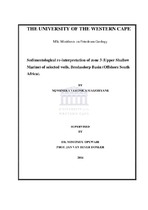| dc.contributor.advisor | Opuwari, Mimonitu | |
| dc.contributor.advisor | Van Bever Donker, Jan | |
| dc.contributor.author | Magobiyane, Nqweneka Veronica | |
| dc.date.accessioned | 2015-11-24T10:37:12Z | |
| dc.date.available | 2015-11-24T10:37:12Z | |
| dc.date.issued | 2014 | |
| dc.identifier.uri | http://hdl.handle.net/11394/4654 | |
| dc.description | >Magister Scientiae - MSc | en_US |
| dc.description.abstract | The Bredasdorp Basin is located on the southern continental margin, off the coast of South Africa. It is mostly filled by marine Aptian to Maastrichtian deposits, overlaying pre-existing Late Jurassic to Early Cretaceous fluvial and shallow marine synrift deposits. The basin is a southeastern trending rift basin, located between the Columbine-Agulhas and Infanta arches. Its basement is made up of slates of the Bokkeveld Group (Devonian) and or quartzites of the Table Mountain Group (Ordovician-Silurian). The study area extends from X-X field to Y-Y field and encompasses only four wells for this investigation; well A, B, C and D respectively. This study was done through the interpretation; integration and juxtaposing of the results from core analysis with wireline log analysis (gamma ray) using Petrel software to display and correlate the well logs. Through core analysis which is the main source of information for this study, seven facies were identified and interpreted for the entire study. These facies alternate throughout each well and between different wells, but they are not evident in all the cores. Throughout the study, well A has been used as a reference well, since it appears (according to the interpretations) to record all seven facies and has the thickest section of zone 3. This zone reflects more accommodation space than the other studied wells at the time of deposition. Facies analysis of cores and well log correlation provide evidence that the studied USM sandstones are compatible with a wave dominated estuary/island-bar lagoon system to shoreface of a wave dominated marine shelf. It has previously been demonstrated that on the northern shelf of the Bredasdorp Basin, the USM typically has an hour-glass gamma ray log signature as a result of long-term transgression and regression and this typical log shape was also identified in this study from well A . | en_US |
| dc.language.iso | en | en_US |
| dc.publisher | University of the Western Cape | en_US |
| dc.subject | Bredasdorp Basin | en_US |
| dc.subject | Facies (Geology) | en_US |
| dc.subject | Wells | en_US |
| dc.subject | Reservoir sedimentation | en_US |
| dc.subject | South Africa | en_US |
| dc.title | Sedimentological re-interpretation of zone 3 (Upper Shallow Marine) of selected wells, Bredasdorp Basin (Offshore South Africa) | en_US |
| dc.type | Thesis | en_US |
| dc.rights.holder | University of the Western Cape | en_US |

